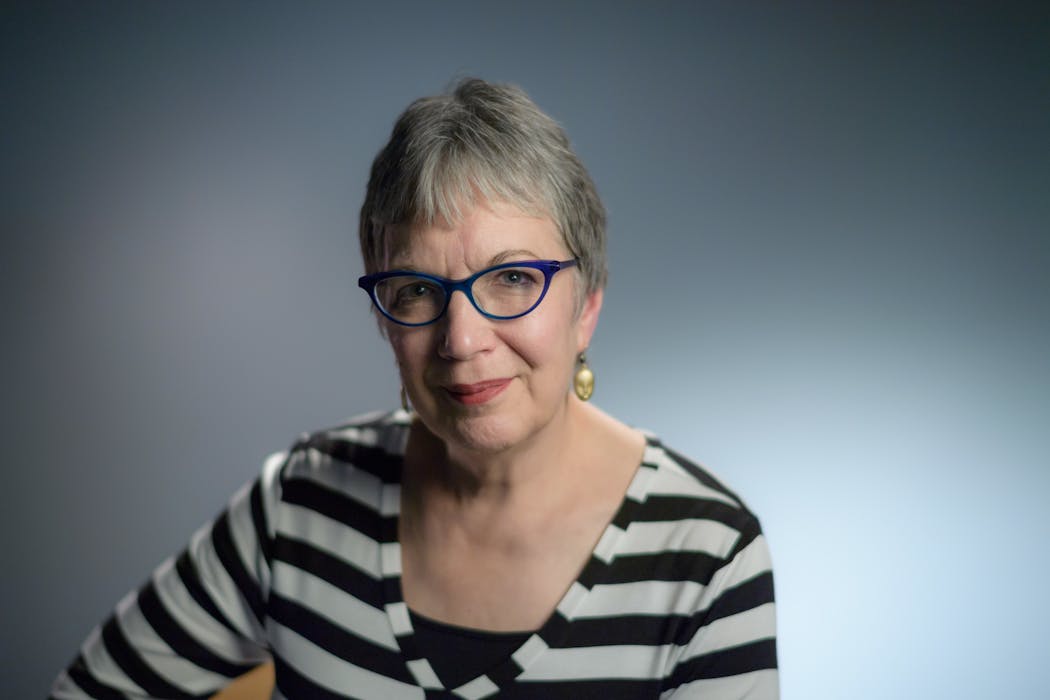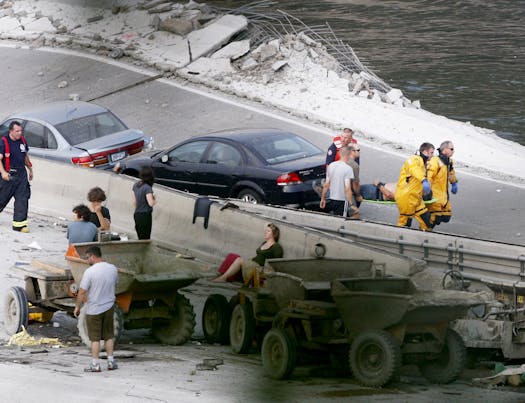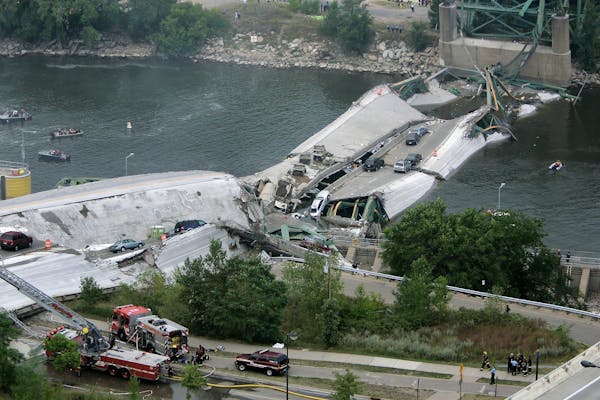Linda Paul: 'I always felt fortunate'
For as terrible as that day was 10 years ago, the years since have been pretty fantastic for Linda Paul.
In many ways, she had no where to go but up.
Caught in what became a landslide of concrete and steel, trapped in a car that bounced down a southbound section of the collapsing I-35W bridge, Paul tried to relax as she fell an estimated 50 to 60 feet, expecting to die. Instead, she suffered fractured vertebrae, broken ribs, a crushed cheekbone and a broken orbital bone. Her eye had to be reset.
"I always felt fortunate," she said.
Days in the hospital led to months of therapy and legislative lobbying. Thanks to the financial settlement obtained by collapse survivors, Paul paid off her mortgage and went to school to change careers. Once an in-home designer, Paul graduated from the architecture program at Dunwoody five years ago and now works as an estimator in commercial construction.
"I'm probably more content than I've ever been in my life," she said.
Her lingering back injuries mean there are many things she cannot do. But Paul prefers to dwell on the expertise she has gained, the respect she has earned in her new career, and the expanded possibilities of her life. She's made it, she said. And she has no survivor's guilt.
"It's not in my nature," Paul said. "I think about it. But I'm not haunted by it."
Andy Gannon: 'I'm a better Andy, post-bridge'
Andy Gannon has done the math. Often.
First, his gas tank was nearly dry. So, before heading north to a funeral in Roseville after work, he stopped to fuel up. Then, as he waited in the turn lane on Washington Avenue, four cars squeezed past him, illegally making a left turn onto the 35W on-ramp ahead of his silver Chrysler Pacifica. He was delayed just enough. "They saved my life," he said.
That's because, after only a few minutes waiting in stalled traffic after getting onto the bridge, Gannon heard a loud cracking sound — then a boom — as the bridge started undulating in waves before his section dropped 50 feet to West River Parkway below.
"My life flashed before my eyes, for sure," he said. "I yelled, 'No! No! No!' and slammed on the brakes to avoid rolling into the car in front of me."
Within seconds, silence. Yet, except for bumping his head on the ceiling of his car, Gannon was unhurt.
In the years since, he has received therapy to come to terms with the guilt he feels for survival. But he also renews a promise to embrace life, to love his wife and daughters and to not let little things, like someone cutting in front of him in traffic, poison his mood.
"I truly appreciate life. It sounds cheesy, but it's so real," said Gannon, who now talks to groups about embracing the good in life. "I'm a better Andy, post-bridge."
Kimberly Brown: 'I wanted to know why it fell'
For years, Kimberly Brown longed to be an author, mulling different ideas. Her relationship with her "complex" mom. Her family. How illness affects the people you love.
"And then this happened," she said.
"This" was plunging toward the Mississippi River atop the 35W bridge on Aug. 1, 2007. Brown was a passenger in a car headed to a soccer game when the bridge fell. "This" is also lingering back pain, recurring PTSD and the need to avoid crowds, parking ramps and tall buildings.
Brown, a technical writer in IT, became an author. Her book, a decade in the making, is both memoir and exposé, exploring why the bridge fell and detailing her personal journey through injury and trauma. "The I-35W Bridge Collapse: A Survivor's Account of America's Crumbling Infrastructure," is being published by the University of Nebraska Press/Potomac Books. Brown anticipates a 2018 release. "I feel really proud of it," she said.
In the aftermath of the collapse, Brown was a vocal and active champion for the victims and survivors, pushing lawmakers to provide the financing to help them rebuild their lives. She also began writing about her emotions, recollections and questions while they were fresh in her mind. Over the years, she's signed up for writing workshops, entered competitions, and consulted with mentors. Eventually, the book emerged.
"I wanted to know why it fell. It didn't seem right that those [13 victims] are gone," she said. "It could have been me."
Garrett Ebling: 'Some things are just hard to shake'
"Whether I like it or not, I am forever one of 'the bridge people.' And despite the ongoing struggles and challenges I face physically and emotionally, I'm quite comfortable with that."
Those are the last words of Garrett Ebling's 2011 memoir, "Collapsed: A Survivor's Climb From the Wreckage of the 35W Bridge," and a foreword to the rest of his life.
Ebling broke both feet, his left arm, and bones throughout his face in the fall. Surgeons had to rebuild his jaw, cheeks and forehead with mesh and metal screws. He lost his sense of smell. He feels pain constantly and struggles to keep his balance while walking.
He was engaged to be married four days before the collapse; he married a year later. He and his wife divorced in early 2015 and have joint custody of their son, Cooper.
Ebling, a former journalist, was working for Great Clips the day the bridge fell. He started a couple of sandwich shops after receiving the financial settlement from the state and bridge contractors, and now is back at Great Clips.
"The emotional journey continues. Some things are just hard to shake," said Ebling, who continues to see a counselor.
Ebling, 42, said his son is his "rock." He tries to teach him the right way to respond to the unforeseen situations that arise in life.
"You have to be relentless, even when things aren't going your way and you want to quit," he said. "I've read the playbook. I've learned life could be a lot worse."
Amy Lindholm: 'I love taking care of people'
Amy Lindholm screamed as she and her gray Saturn sedan plunged 117 feet to the Mississippi River atop a slab of concrete. Seconds before, she'd been stuck on the 35W bridge, on the phone with her father.
"We started moving, then, all of a sudden, everything started disappearing on me," she said. "I just remember rebar coming toward me. Then it all just went dark."
She told her father, who was still on the line, that she'd fallen in the river. Then, wearing the tan and blue scrubs she'd worn that day at her job as a medical assistant, Lindholm got out of her car and began to help dozens of others who'd fallen with her — checking injuries, cleaning wounds, letting survivors use her phone. It wasn't until hours later, after rescue workers shooed her away and she scrambled up the riverbank to wait for a ride home, that her own pain overwhelmed her.
Doctors found serious damage to Lindholm's back and, nearly a year later, surgeons replaced a shattered vertebra and implanted rods to stabilize herniated discs. With her share of settlement money, she bought a modest home near Lake Nokomis for herself, her sister, Lindholm's daughter and their dog Tootsie. Despite being permanently disabled from the collapse, she once again works as a medical assistant.
"I love my job," she said. "I love taking care of people."
Carole Blackhawk: 'Don't let her be on that bridge'
Carole Blackhawk's heart shattered 10 years ago, when her daughter Julia, a passenger in a car on the I-35W bridge, was killed when the bridge collapsed.
Life's gotten no better in the decade since.
Blackhawk's daughter-in-law, Shirley Kreider, died on Christmas five years ago from complications following surgery. Two years ago, Blackhawk mourned yet again after her son, David Kreider, was found strangled on a football field in Nebraska. He'd spent much of his life enmeshed with gangs and drugs.
"We've been a poor family," Blackhawk said in a soft voice.
Julia Blackhawk, Carole's youngest daughter, was a source of hope. At 32, she had been accepted as a hairstylist trainee at Aveda and dreamed of living in Paris or Japan.
On Aug. 1, 2007, Julia needed a ride home from Minneapolis to Savage. Since her mother was using the family car, Julia got a ride from an ex-boyfriend.
They never made it out of Minneapolis.
Carole Blackhawk heard about the bridge collapse on the car radio as she was driving that afternoon. "Please God, don't let her be on that bridge," she prayed. But calls to Julia's cellphone went unanswered and Carole went to bed. At 2 a.m., her oldest daughter woke her to break the news.
They buried Julia in a traditional Winnebago ceremony on their home reservation in Nebraska. Julia's two young sons went to live with their paternal grandmother in Massachusetts. They're grown now and living "on the streets" in Minneapolis, Carole Blackhawk said.
While she said she's "moved on" from the events of a decade ago, she mourns Julia still. "If there was something I could change, the only thing would be to bring her home."

Baseball Metro Player of the Year packs up his five tools and leaves

Prep baseball 2024: 35 Minnesota stars who the recruiters covet
Police searching for St. Paul home intruder who raped, robbed woman

Friend heard money, relationship woes from man tied to Chanhassen killing who took his own life







